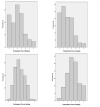Understanding treatment-seeking smokers' motivation to change: content analysis of the decisional balance worksheet
- PMID: 23017735
- PMCID: PMC3493681
- DOI: 10.1016/j.addbeh.2012.08.008
Understanding treatment-seeking smokers' motivation to change: content analysis of the decisional balance worksheet
Abstract
The Decisional Balance Worksheet (DBW), an open-ended measure of motivation to change, may be used to record the pros and cons of smoking versus abstinence among treatment-seeking smokers. Recent findings indicated that the open-ended DBW could be quantified to validly reflect people's level of motivation to stop smoking (Collins, Eck, Torchalla, Schröter, & Batra, 2010). The goal of the current study was to enhance our understanding of these participants' motivation to change by examining the qualitative content of their decisional balance. Participants were treatment-seeking smokers (N=268) who had participated in a larger randomized controlled trial of tailored smoking cessation interventions (Batra et al., 2010). Using the DBW, participants recorded their pros and cons of smoking versus abstinence, and content analysis methods were used to extract common themes. Findings indicated that the physical and psychological effects/functions of smoking and abstinence were most commonly mentioned as both pros and cons. Although the decisional balance categories were substantively similar over time, their relative frequency shifted from pre- to posttreatment. For the sample as a whole, the number of pros of smoking generally decreased, whereas the pros of abstinence increased from pre- to posttreatment. Findings suggest that clinicians can expect certain perceived pros and cons to characterize their clients' decision-making process about smoking and abstinence. At the same time, the use of the decisional balance allows for assessment of individuals' unique motivational set.
Copyright © 2012 Elsevier Ltd. All rights reserved.
Figures


References
-
- Abrams DB, Herzog TA, Emmons KM, Linnan L. Stages of change versus addiction: a replication and extension. Nicotine and Tobacco Research. 2000;2:223–229. doi: 10.1080/1462220005014748. - PubMed
-
- Batra A, Collins SE, Schröter M, Eck S, Torchalla I, Buchkremer G. A cluster-randomized effectiveness trial of smoking cessation modified for at-risk smoker subgroups. Journal of Substance Abuse Treatment. 2010;38:128–140. doi: 10.1016/j.jsat.2009.08.003. - PubMed
-
- Batra A, Collins SE, Torchalla I, Schröter M, Buchkremer G. Multidimensional smoker profiles and their prediction of smoking following a pharmacobehavioral intervention. Journal of Substance Abuse Treatment. 2008;35:41–52. doi: 10.1016/j.jsat.2007.08.006. - PubMed
-
- Biener L, Abrams DB. The Contemplation Ladder: Validation of a measure of readiness to consider smoking cessation. Health Psychology. 1991;10:360–365. doi: 10.1037//0278-6133.10.5.360. - PubMed
-
- Borland R, Yong H-H, Balmford J, Cooper J, Cummings KM, O’Connor RJ, Fong GT. Motivational factors predict quit attempts but not maintenance of smoking cessation: Findings from the International Tobacco Control Four Country Project. Nicotine and Tobacco Research. 2010;12:S4–S11. doi: 10.1093/ntr/ntq050. - PMC - PubMed
Publication types
MeSH terms
Grants and funding
LinkOut - more resources
Full Text Sources
Other Literature Sources
Medical
Miscellaneous

